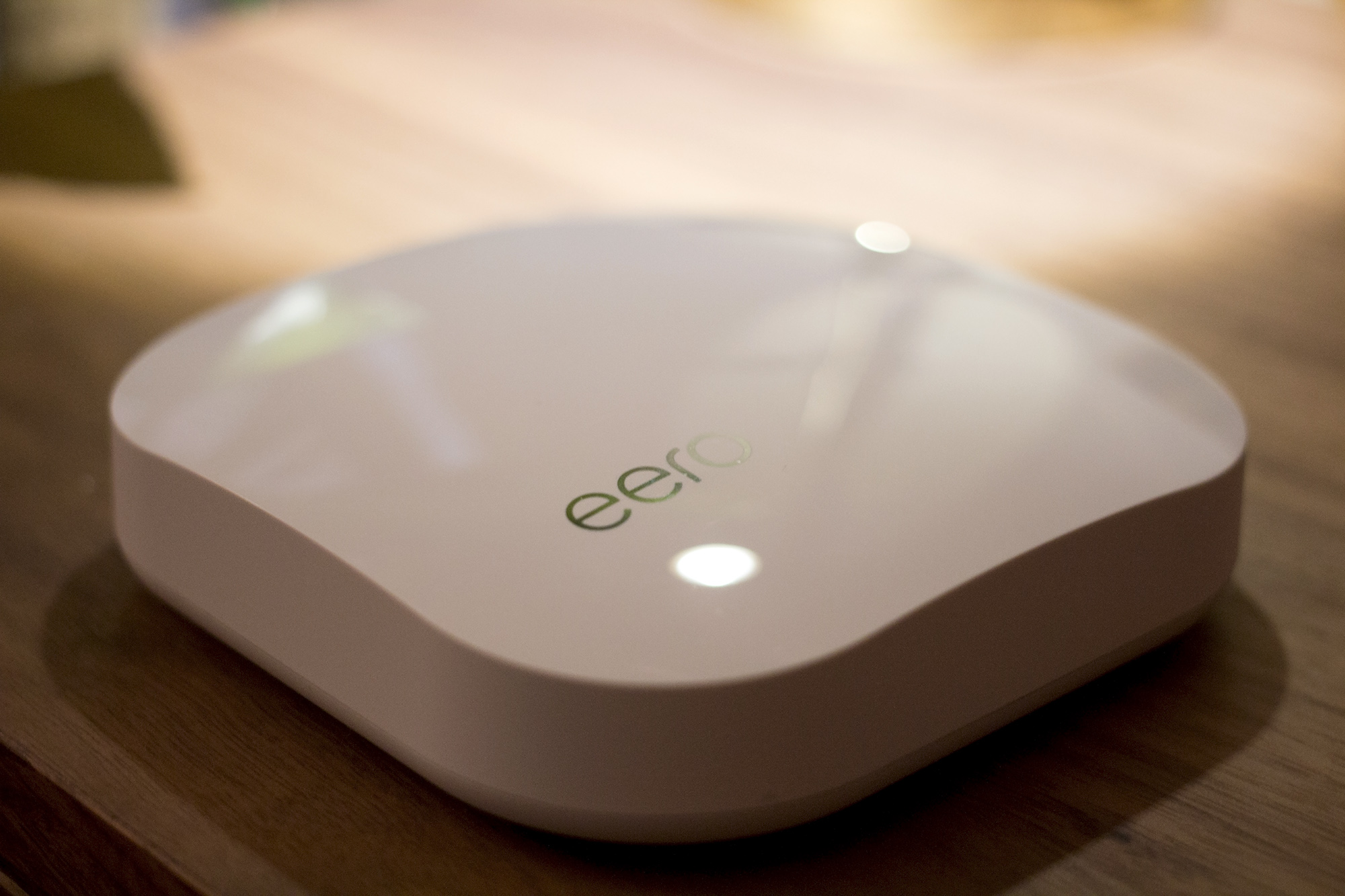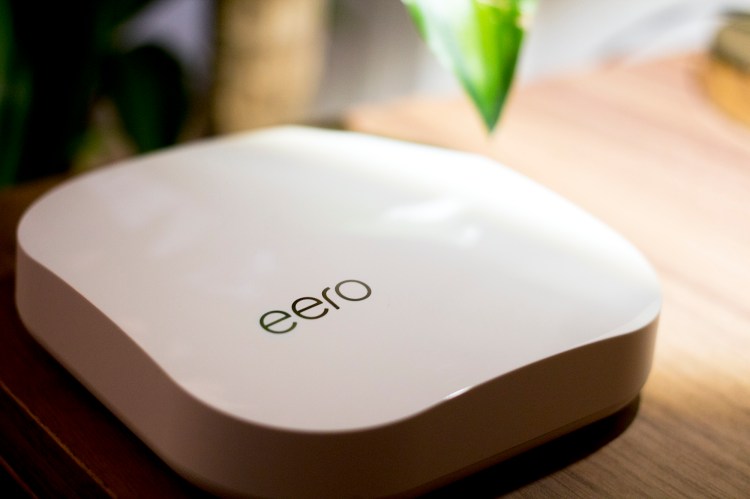Eero is one hell of a fancy router.
At almost $500 for a three-pack (and $200 a pop), Eero’s router system is pricey. But the Eero ships with big promises: “No more buffering,” “No more dead zones,” and “Wi-Fi that actually works.” Could it be true?
If you buy just one Eero, you’ll get “the best router you’ve ever owned,” Eero CEO Nick Weaver boasts. And if you buy more than one — three apparently cover the average U.S. home — your Eeros will form a mesh network to extend your Wi-Fi coverage. Eeros, when placed within range of each other, help your Wi-Fi signal travel around walls from room to room and floor to floor.
In an interview with VentureBeat, Weaver likened the way Wi-Fi travels to sound from a loudspeaker or a brightness from a stage light:
Wi-Fi is a radio wave, just like light and sound. So there are two different types of Wi-Fi: 2.4GHz Wi-Fi (the older stuff) and the newer standard, 802.11ac, that runs at 5GHz.
So 2.4GHz Wi-Fi, a good analogy would be: Go get a really loud speaker, put it in your living room. Now go to your bedroom or your kitchen — you’ll still hear things but faintly. 5GHz Wi-Fi: You get a really bright light, like a stage light, and put that in your living room — you’re not going to see any of that in your bedroom.
The only way you’re going to fundamentally fix that is by having multiple units throughout your home.
The test
Getting everything set up via Eero’s app took about ten minutes. I speed-tested the Eero against my old router, an Optimum-branded D-Link DIR-868L (admittedly the best router an ISP has ever given me), at five- to 10-minute intervals (arbitrarily selected) on Sunday evening, twice in each room.
With an Eero in my living room connected to my modem, one Eero in my bedroom, and another in my office, the system increased average download speeds in the apartment by about 41 percent. Put another way: Download speeds offered by the Eero were about 33mbps faster than what my old router offered. The fastest download speed I clocked was just over 114mbps, so in this case, 33mbps faster matters.
The Eero also solved the occasional connection spottiness I’ve experienced in my office, the furthest spot from the living room (and my usual modem). At one point, with my old router, I recorded crawling sub-3mbps speeds in my office; with the Eero, that didn’t happen.
Note: View my math and speed test results here. This rudimentary test involved one device, one independent speed testing service, and one time of day. A comprehensive study by wireless engineers could reveal a lot more or yield different results!
The Eero is the best router I’ve used, to date. It’s controlled by a crisp-looking app, it’s pretty easy to set up, the hardware is reminiscent of Apple, and it’s supposed to get better with age via over-the-air updates (privacy-minded folks, we’ll get to that in a moment). I encountered few errors — the first and second Eeros I set up didn’t activate on the first try, but that amounted to only a minute or two lost. Broadly speaking, this is a great device if you’re willing to invest in it.

Prior to Eero’s launch (it’s available now) we sat down with Weaver to talk design, auto-updates, security, and why home Wi-Fi is still so infuriating in 2016. Here’s our interview, edited and trimmed for clarity.
VentureBeat: Are you solving a problem that people don’t know they have?
Nick Weaver, Eero CEO: A lot of people say, “Oh my Internet connection sucks,” and it’s because they’ll go in their living room where their connection comes in and everything works great. And they’ll go back to their bedroom, and things won’t work, and they’ll blame it on their connection. It’s actually their Wi-Fi service.
A great test to do is go run a speed test in your living room, and then go to two other rooms in your apartment or your house, and try it there. You’ll see how quickly the speeds drop off as you move around.
VB: I’ve never done that.
Weaver: There is a bit of an education piece. Frankly, given the reception we’ve had with the product and the company so far, a lot of people know they have this problem, and they’ll literally do anything they can to fix it.
VB: Is it necessary to put this in every home?
Weaver: Go try that speed test yourself. The way I like to phrase it is: If you get a single Eero, that’s the best router you’ve ever owned … This is the easiest product to set up on the market and it keeps getting better over time. We have auto-updates — every night it checks for new software. Eero today versus Eero a year from now — the software just keeps getting better … and the product keeps improving. And that’s unlike any other product out there.
… Especially as you’re connecting all of these devices to your home, you really need to have a really high quality product that’s providing connectivity, especially on the security side of things. And so, for us, even if you have one unit, you know your network’s always going to work, and you know it’s always going to be secure.
VB: So you know how Google has routers? Is that just like, the best of an old thing?
Weaver: Uh, yeah, that’s actually a pretty good way of putting it. For their product, it’s still the same router manufacturers that have built crappy hardware for the last 20 years building the product. And it also doesn’t fix this coverage problem. Those products are not meant to have multiple units all tied together.
VB: And Facebook is working on mesh networks, too?
Weaver: The way mesh has been deployed in the past has been for large municipal city networks. So in New York, a lot of the street lights and traffic lights are connected over a mesh network. In cities, and for municipalities, it’s a totally different use case. They’re similar concepts .. but it’s applied very differently.
VB: Are there any security nuts who wouldn’t like their router talking to your server all the time?
Weaver: We’re really careful about what information we send, so at no point do we ever record where you’re going on the Internet.
VB: Can you?
Weaver: No, that’s not a capability of our software. We designed it that way. That’s not information I ever want to know.
VB: No, you don’t.
Weaver: The only information we have is diagnostic information. And anything that’s displayed in the app. We have no concept of where you’re going or how you’re using your connection — don’t ever want to know.
On the benefits, though, of having your network update automatically: Last year there were security issues like Heartbleed … what’s great is we can patch and fix those problems immediately and update every Eero network. Versus, like, if you look at some of our competitors, most people have never updated the firmware on their network.
VB: Does your goal start and end with fixing home Wi-Fi?
Weaver: If you look at what we’re laser focused on today, it’s fixing connectivity in people’s homes. But if you look at what our team has done, we’ve taken one of the most complicated pieces of hardware in your home and stripped away all the complexity so anybody can use it.
It’s a new way of thinking about connected hardware. It’s delivering gorgeous hardware that people are proud of having in their homes, and it’s taking all this complexity and making the end product incredibly simple. So that’s what we do at Eero. We just happen to be fixing your home Wi-Fi, right now.
For more coverage of the eero router, read VentureBeat’s Design fetish: Behold Eero, the most beautiful Wi-Fi router, ever.



